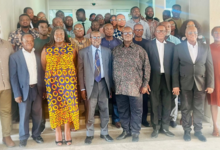
Like the Israelites in the biblical journey through the wilderness, the school children from Nwamase, a community in the West Akim Municipality of the Eastern Region, embark on a challenging journey every day. They navigate through the rugged terrain, fighting off thorny bushes and harmful leaves as they make their way to school.
These young ones, who are often barefoot, brave the harsh elements of nature, keeping a watchful eye for snakes and other wild animals lurking in the shadows.
But despite the difficulties they face, these children push on, determined to gain an education that will provide a better and brighter future for them and their families.
This struggle is not unique to Nwamase, as many children from rural communities across Ghana undertake a similar journey, persevering through the challenges of their environment to access an education. Their journey, much like the biblical one, is one of sacrifice, determination, and hope.
Education as a right
Education as a fundamental human right is enshrined in the Universal Declaration of Human Rights (1948) and many other international human rights instruments. The United Nations Educational, Scientific and Cultural Organisation (UNESCO)’s primary standard-setting instrument is the Convention against discrimination in education which dates from 1960 and has so far been ratified by 107 States.
It is the first international instrument which covers the right to education extensively and has a binding force in international law. The Convention also acts as a cornerstone of the Education 2030 Agenda and Sustainable Development Goal 4 for education adopted by the international community. SDG 4 is rights-based and seeks to ensure the full enjoyment of the right to education as fundamental to achieving sustainable development.
In Ghana, the right to education is guaranteed in the 1992 Constitution which states in Article 38(2) that “The Government shall within two years after Parliament first meets after coming into force of this Constitution draw up a programme for the implementation within the following 10 years for the provision of a Free, Compulsory Universal Basic Education.”
Additionally, the Education Act, 2008 (Act 778) and the Children’s Act, 1998 (Act 560) also guarantee the right to education in Ghana. Act 560 consolidates the law relating to children by providing for the rights of the child, maintenance and adoption, and by regulating child labour, apprenticeship and related matters.
The contrast
Although Ghana’s educational system has seen significant improvement since the country’s independence, it is still coupled with some challenges but narrowing them to the rural areas, the progress appears not to be enough.
This situation undoubtedly holds back the pace of educational development in Ghana today and results in a huge gap between children from rural and urban areas in terms of quality education.
In a 2021 study by Doris Dokua Sasu, available on Statista, between 87 per cent and 91 per cent of urban localities had access to basic education. On the other hand, the share was lower among rural communities.
Only 40 per cent of the rural areas had access to Junior High Schools (JHS), while pre-primary education was available to 38.7 per cent of the rural communities. Overall, as of 2019, around 35,000 children of primary school age were unenrolled in school in Ghana.
In light of that, rural education in Ghana is characterised by low enrolment, lack of professionally trained teachers, poor infrastructural facilities, lack or inadequacy of teaching and learning materials says a Ghana Statistical Services report.
This development makes dropouts in the rural areas peculiar and worth investigating. Most basic level dropouts have serious educational deficiencies that have severe consequences on them throughout their adult lives by limiting their economic and social well-being.
Akwadum/Asuofori
situation
At Akwadum/Asuofori in West Akim, some students revealed to the Ghanaian Times that they had to walk over an hour to access basic education. A journey which sometimes does not always go smoothly as some of the students are bitten by snakes, cut by exposed parts of felled trees and injured when they fall.
The journey often left the students tired hence their inability to concentrate in the classrooms forcing some to become truants.
Truancy, a dangerous and common phenomenon seen in the schools in the rural areas which if not checked would slowly ensure that the children were lost to illegal mining activities popularly known as “Galamsey” and in extreme circumstances, crime.
MCE’s corroboration
Acknowledging the dangers posed by the long journeys children had to embark on to access basic education, the Municipal Chief Executive for the West Akim Municipal Assembly, Mr Seth Oduro-Boadu, underscored the importance of the government and stakeholder investment in the education of children living in the rural parts of the country.
He stated that his outfit was in constant talks with the education directorate to provide Junior High School blocks and other educational structures for the community to further stimulate their interest towards getting an education.
“Here in this community there’s no JHS block so the children have to walk several kilometres to other communities to access junior high education,” he lamented.
Comparing his municipality to other areas he expressed excitement about the student enrolment in schools although they had to walk several kilometres to school as it was the best compared to other mining communities where the students abandon the classrooms to engage in ‘galamsey’.
NGO intervention
Earlier this year, the Executive Director of Child rights International, Mr Bright Appiah, through his NGO and Mondelez International Cocoa Life provided multipurpose tricycles to some rural communities in Sekyere East in the Ashanti Region, West Akim in the Eastern Region and Awutu Senya in the Central Region to bridge the educational gap.
In an interview with the Ghanaian Times, he explained that the purpose for undertaking such a project was to assist the children to get to their various schools and avoid the difficulties they had to go through to access education and also enhance the quality of education in the rural communities.
He is among many private individuals trying to further narrow the already widened educational gap in the rural areas.
Conclusion
Moving forward, the government and its development partners ought to beef up their efforts of ensuring access to pre-primary education, especially in the rural and deprived communities if its goal of ensuring equal access to free and quality education was to be achieved.
Education is supposed to equip people with the knowledge and skills they need to contribute to economic growth and poverty reduction. But have we provided the tools to demand excellence from our students?
BY JESSEL LARTEY THERSON-COFIE







